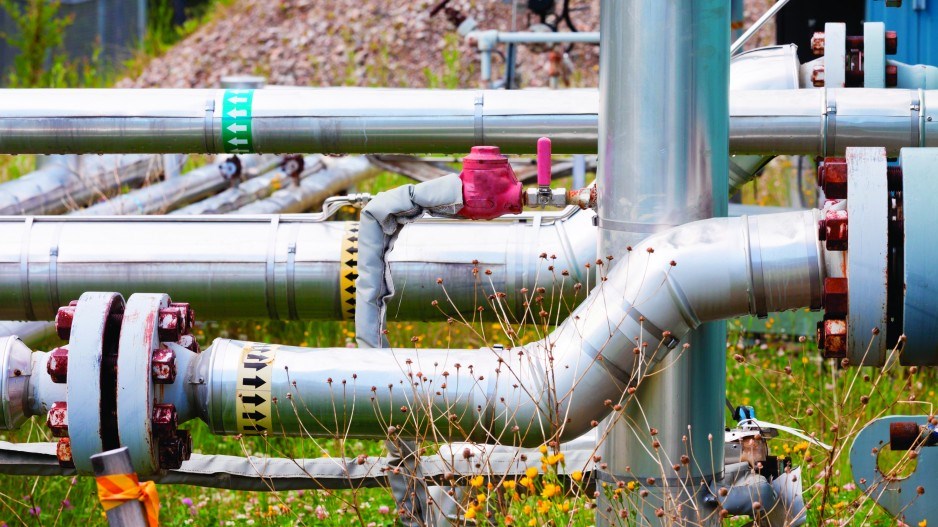More questions are being raised over the accuracy of the federal government’s new calculations of upstream greenhouse gas emissions for energy projects such as pipelines and liquefied natural gas plants.
Last week, the Pembina Institute wrote the Canadian Environmental Assessment Agency (CEAA) to suggest the agency’s recent calculations for the Woodfibre LNG project in Squamish – based in part on the Pembina Institute’s calculation tools – might have been low because methane leakage could have been underestimated.
“Because we don’t have good B.C. studies, we don’t know what the actual number is,” said Pembina Institute regional director Matt Horne.
The clean-energy think-tank supports the federal government’s decision to require all CEAA reviews of industrial projects to include a calculation of the potential upstream (at the point of extraction or processing) greenhouse gas (GHG) emissions associated with them.
In the past, that was not part of the review process for pipelines or other large industrial projects.
But in the case of liquefied natural gas (LNG) projects in B.C., getting an accurate calculation is being frustrated in part by a lack of accurate data.
Climate change policies tend to focus on reducing carbon emissions. But for the unconventional oil and gas sector, methane is becoming both a bigger concern and, potentially, a bigger opportunity for GHG reduction.
Though it is less persistent in the atmosphere than carbon dioxide, methane’s global warming potential is 85 times greater. Methane from oil and gas accounts for 6% of Canada’s total GHG emissions, according to a recent study by ICF International.
The good news is that every dollar invested in reducing or eliminating methane emissions yields a disproportionately higher GHG reduction. The bad news for B.C. and its aspirations to develop an LNG industry is that it has no regulations limiting methane from upstream gas activities.
It also appears B.C. might not even have a good handle on just how much methane escapes in leakage from gas wells, valves and pipelines.
In its response to the CEAA’s recent calculations for the upstream GHG emissions for Woodfibre LNG, the Pembina Institute warns that the numbers used for B.C.’s methane leakage rates appear to be five times lower than the rates reported by the Environmental Protection Agency in the U.S.
“The reporting of methane from fugitive emissions associated with fracking is woeful in B.C.,” said Andrew Weaver, a former climate scientist and Green Party MLA for Oak Bay-Gordon Head.
Sealing methane leaks from wells and pipelines, and avoiding venting, is a fairly straightforward engineering fix.
Compared with capital-intensive carbon capture technology and bringing hydroelectricity to the natural gas fields of northeastern B.C., addressing the methane problem could be the most cost-effective way to reduce GHGs from the natural gas industry and the nascent LNG industry.
But of all the major gas-producing jurisdictions in North America, B.C. appears to be the only one that has not yet put methane regulations in place. In November, Alberta introduced regulations designed to cut methane emissions from the oil and gas sector by 45% by 2025.
“There’s a technology choice there which, without regulations, some practices are quite poor and some are quite good, and we need regulation and policy to steer it towards the right practices,” Horne said. He is “fairly optimistic” that B.C. will address the methane problem with new regulations when it updates its climate action plan.
Weaver is less optimistic. He doesn’t have much faith in the B.C. government to tighten regulations, lest it scare off an industry that some fear is having second thoughts, due to market conditions.
“The government is still so desperate to land LNG that they’re introducing a bill that we’ll be discussing that actually weakens our already weak laws even more,” he said, referring to the Greenhouse Gas Industrial Reporting and Control Amendment Act. “I cannot see this government bringing in place any methane regulation of any substance any time soon.”
At the federal level, however, Canada and the U.S. last week struck an agreement on climate change that includes new methane regulations for the Canadian and American oil and gas sectors. Under that agreement, Environment Canada will regulate methane emissions from new and existing oil and gas sources, and both countries will work toward a phase-out of flaring by 2030.
Two weeks ago at a Globe 2016 conference, Diane Regas, executive director of the Environmental Defense Fund, said she thought LNG could play a role in helping the world move to a lower-carbon era – if the methane problem is addressed.




